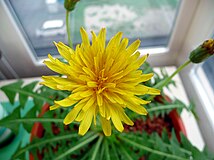Taraxacum
| Taraxacum Temporal range: Miocene–recent
| |
|---|---|
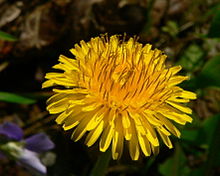
| |

| |
| A dandelion flower head composed of numerous small florets (top). The seedhead is shown below it. | |
| Scientific classification | |
| Kingdom: | Plantae |
| Clade: | Tracheophytes |
| Clade: | Angiosperms |
| Clade: | Eudicots |
| Clade: | Asterids |
| Order: | Asterales |
| Family: | Asteraceae |
| Subfamily: | Cichorioideae |
| Tribe: | Cichorieae |
| Subtribe: | Crepidinae |
| Genus: | Taraxacum F. H. Wigg. |
| Type species | |
| Taraxacum officinale[2] | |
| Species | |
|
See text | |
| Synonyms | |
|
List
| |
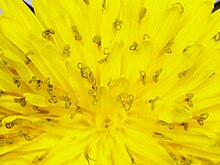
Taraxacum(/təˈræksəkəm/)[3]is a largegenusofflowering plantsin the familyAsteraceae,which consists of species commonly known asdandelions.The scientific and hobby study of the genus is known as taraxacology.[4]The genus is native to Eurasia but the two most commonplace species worldwide,T. officinale(the common dandelion) andT. erythrospermum(the red-seeded dandelion), were introduced from Europe into North America, where they are invasive aliens.[5]Dandelions thrive in temperate regions and can be found in yards, gardens, sides of roads, among crops, and in many other habitats.[6]Both species areediblein their entirety[a]and have a long history of consumption.[7]The common namedandelion(/ˈdændəlaɪ.ən/DAN-də-ly-ən;fromFrenchdent-de-lion'lion's tooth', referring to the jagged leaves) is also given to specific members of thegenus.[8]
Like other members of the family Asteraceae, they have very small flowers collected together into a compositeflower head.Each single flower in a head is called afloret.In part due to their abundance, along with being ageneralist species,dandelions are one of the most vital early springnectarsources for a wide host ofpollinators.[9]ManyTaraxacumspecies produce seedsasexuallybyapomixis,where the seeds are produced withoutpollination,resulting in offspring that are genetically identical to the parent plant.[10]
In general, the leaves are 50–250 mm (2–10 in) long or longer, simple, lobed-to-pinnatisect, and form a basalrosetteabove the central taproot. Theflower headsare yellow to orange coloured, and are open in the daytime, but closed at night. The heads are borne singly on a hollow stem (scape) that is usually leafless and rises10–100 mm (3⁄8–3+7⁄8in) or more[5]above the leaves. Stems and leaves exude a white, milkylatexwhen broken. A rosette may produce several flowering stems at a time. The flower heads are20–50 mm (3⁄4–2 in) in diameter and consist entirely of rayflorets.The flower heads mature into spherical seed heads sometimes calledblowballs[11]orclocks(in both British and American English)[12][13][14][15]containing many single-seeded fruits calledcypselae,similar toachenes.Each cypsela is attached to apappusof fine hair-like material which enablesanemochorous(wind-aided) dispersal over long distances.[citation needed]
The flower head is surrounded bybracts(sometimes mistakenly calledsepals) in two series. The inner bracts are erect until the seeds mature, then flex downward to allow the seeds to disperse. The outer bracts are often reflexed downward, but remain appressed in plants of the sectionsPalustriaandSpectabilia.Between the pappus and the achene is a stalk called a beak, which elongates as the fruit matures. The beak breaks off from the achene quite easily, separating the seed from the parachute.[16]
Description[edit]


The species ofTaraxacumaretap-rooted,perennial,herbaceousplants, native totemperateareas of the Northern Hemisphere. The genus contains many species, which usually (or in the case oftriploids,obligately) reproduce byapomixis,resulting in many local populations andendemism.In the British Isles alone, 234microspecies(i.e. morphologically distinct clonal populations) are recognised in nine loosely defined sections, of which 40 are "probably endemic".[17]A number of species ofTaraxacumare seed-dispersedruderalsthat rapidly colonize disturbed soil, especially the common dandelion (T. officinale), which has been introduced over much of the temperate world. After flowering is finished, the dandelion flower head dries out for a day or two. The dried petals and stamens drop off, the bracts reflex (curve backwards), and the parachute ball opens into a full sphere. When development is complete, the mature seeds are attached to white, fluffy "parachutes" which easily detach from the seedhead and glide by wind, dispersing.
The seeds are able to cover large distances when dispersed due to the unique morphology of thepappuswhich works to create a unique type ofvortex ring[18][19]that stays attached to the seed rather than being sent downstream. In addition to the creation of this vortex ring, the pappus can adjust its morphology depending on the moisture in the air. This allows the plume of seeds to close up and reduce the chance to separate from the stem, waiting for optimal conditions that will maximize dispersal and germination.[20][21]


Similar plants[edit]

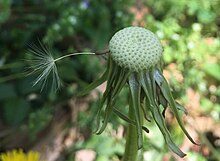
Many similar plants in the familyAsteraceaewith yellow flowers are sometimes known asfalse dandelions.Dandelion flowers are very similar to those of cat's ears (Hypochaeris). Both plants carry similar flowers, which form into windborne seeds. However, dandelion flowers are borne singly on unbranched, hairless and leafless, hollow stems, while cat's ear flowering stems are branched, solid, and carry bracts. Both plants have a basal rosette of leaves and a central taproot. However, the leaves of dandelions are smooth or glabrous, whereas those of cat's ears are coarsely hairy.[17]: 740
Early-flowering dandelions may be distinguished fromcoltsfoot(Tussilago farfara) by their basal rosette of leaves, their lack of disc florets, and the absence of scales on the flowering stem.[22]
Other plants with superficially similar flowers includehawkweeds(Hieracium) andhawksbeards(Crepis). These are readily distinguished by branched flowering stems, which are usually hairy and bear leaves.[17]: 740
Classification[edit]
The genus istaxonomicallycomplex due to the presence of apomixis: any morphologically distinct clonal population would deserve its ownmicrospecies.Phylogenetic approaches are also complicated by the accelerated mutation in apomixic lines and repeated ancient hybridization events in the genus.[23]
As of 1970, the group is divided into about 34 macrospecies orsections,and about 2000microspecies;[24]some botanists take a much narrower view and only accept a total of about 60 (macro)species.[24]By 2015, the number has been revised to include 60 sections and about 2800 microspecies. 30 of these sections are known to reproduce sexually.[23]
About 235apomicticandpolyploidmicrospecies have been recorded in Great Britain and Ireland alone.[25]
Botanists specialising in the genusTaraxacumare sometimes called taraxacologists,[26]for exampleGunnar Marklund,Johannes Leendert van Soestor A.J. Richards.[27]
Selected species[edit]
- Taraxacum albidum,the white-flowered Japanese dandelion, ahybridbetweenT. coreanumandT. japonicum
- Taraxacum algarbiense
- Taraxacum aphrogenes,the Paphos dandelion
- Taraxacum arcticum
- Taraxacum balticum
- Taraxacum brachyceras
- Taraxacum brevicorniculatum,frequently misidentified asT. kok-saghyzand a poor rubber producer[28]
- Taraxacum californicum,the California dandelion, an endangered species
- Taraxacum carneocoloratum
- Taraxacum centrasiaticum,the Xin gian g dandelion
- Taraxacum ceratophorum,the horned dandelion, considered by some sources to be a North American subspecies ofT. officinale(T. officinalesubsp.ceratophorum)[29]
- Taraxacum coreanum
- Taraxacum desertorum
- Taraxacum erythrospermum,the red-seeded dandelion, often considered a variety ofT. laevigatum(i.e.,T. laevigatumvar.erythrospermum)[30]
- Taraxacum farinosum,the Turkish dandelion
- Taraxacum holmboei,the Troödos dandelion
- Taraxacum hybernum
- Taraxacum japonicum,the Japanese dandelion, no ring of smallish, downward-turned leaves under the flower head
- Taraxacum kok-saghyz,the Kazakh dandelion, which produces rubber[31][28]
- Taraxacum laevigatum,the rock dandelion, achenes reddish brown and leaves deeply cut throughout the length, inner bracts' tips are hooded
- Taraxacum lissocarpum
- Taraxacum minimum
- Taraxacum mirabile
- Taraxacum officinale(syn.T. officinalesubsp.vulgare), the common dandelion, found in many forms
- Taraxacum pankhurstianum,the St. Kilda dandelion
- Taraxacum platycarpum,the Korean dandelion
- Taraxacum pseudoroseum
- Taraxacum rubifolium,a near-extinct species.[32][33]
- Taraxacum suecicum
Cultivars[edit]
- 'Amélioré à Coeur Plein' yields an abundant crop without taking up much ground, and tends toblanchitself naturally, due to its clumping growth habit.
- 'Broad-leaved' - The leaves are thick and tender and easily blanched. In rich soils, they can be up to 60 mm (2') wide. Plants do not go to seed as quickly as French types.
- 'Vert de Montmagny' is a large-leaved, vigorous grower, which matures early.[34]
History[edit]


Dandelions are thought to have evolved about 30 million years ago inEurasia.[35]Fossilseeds ofTaraxacum tanaiticumhave been recorded from thePlioceneof southernBelarus.[36]Dandelions have been used by humans for food and as anherbfor much of recorded history. They were well known to ancient Egyptians, Greeks and Romans, and are recorded to have been used intraditional Chinese medicinefor over a thousand years. The plant was used as food and medicine byNative Americans.[37]Dandelions were probably brought to North America on theMayflowerfor their supposed medicinal benefits.[38]
Etymology[edit]

The Latin nameTaraxacumoriginates inmedievalArabic writings on pharmacy. The scientistAl-Raziaround 900 CE wrote "the tarashaquq is like chicory".[citation needed]The scientist and philosopherIbn Sīnāaround 1000 CE wrote a book chapter onTaraxacum.[citation needed]Gerard of Cremona,in translating Arabic to Latin around 1170, spelled ittarasacon.[39]
Common names[edit]
The English name, dandelion, is acorruptionof the Frenchdent de lion[40]meaning "lion's tooth", referring to the coarsely toothed leaves. The plant is also known as blowball, cankerwort, doon-head-clock, witch's gowan, milk witch, lion's-tooth, yellow-gowan, Irish daisy, monks-head, priest's-crown, and puff-ball;[41]other common names includefaceclock,pee-a-bed,wet-a-bed,[42] swine's snout,[43]white endive, and wild endive.[44]
The English folk name "piss-a-bed"(and indeed the equivalent contemporary Frenchpissenlit) refers to the strongdiureticeffect of the plant's roots.[45]In various northeastern Italian dialects, the plant is known aspisacan( "dog pisses"), because they are found at the side of pavements.[46][unreliable source?]InSwedish,it is calledmaskros(worm rose) after the nymphs of small insects (thripslarvae) usually present in the flowers.[47]
Nutrition[edit]
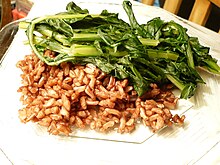
Raw dandelion greens contain high amounts of vitaminsA,C,andK,and are moderate sources ofcalcium,potassium,iron,andmanganese.[48]Raw dandelion greens are 86% water, 9%carbohydrates,3%protein,and 1%fat.[48]A 100 gram (3+1⁄2oz) reference amount supplies 45Calories.[48]
Phytochemicals[edit]
The raw flowers contain diversephytochemicals,includingpolyphenols,such asflavonoidsapigenin,isoquercitrin (aquercetin-like compound), andcaffeic acid,as well asterpenoids,triterpenes,andsesquiterpenes.[49]The roots contain a substantial amount of the prebiotic fiberinulin.Dandelion greens containlutein.[50]
Taraxalisin,a serineproteinase,is found in thelatexof dandelion roots.[51][52]Maximal activity of the proteinase in the roots is attained in April, at the beginning of plant development after the winter period.[52]Each dandelion seed has a mass(weight) of 500 micrograms or 0.0005g (1/125 of a grain).[citation needed]
Properties[edit]
Edibility[edit]

The entire plant, including the leaves, stems, flowers, and roots, is edible and nutritious, with nutrients such as vitamins A and K as well as calcium and iron. [53]Dandelions are found on six continents and have been gathered for food since prehistory, but the varieties commercially cultivated for consumption are mainly native toEurasiaandNorth America.Aperennial plant,its leaves grow back if thetaprootis left intact. To make leaves more palatable, they are oftenblanchedto remove bitterness,[54]orsauteedin the same way asspinach.[55]Dandelion greens have been a part of traditionalKashmiri cuisine,Lebanese cuisine,[56]Spanish cuisine,Italian cuisine,Albanian cuisine,Slovenian,Sephardic Jewish,Chinese,Greek cuisine(χόρτα) andKorean cuisines.InCrete,the leaves of a variety called 'Mari' (Μαρί), 'Mariaki' (Μαριάκι), or 'Koproradiko' (Κοπροράδικο) are eaten by locals, either raw or boiled, in salads.T. megalorhizon,a species endemic to Crete, is eaten in the same way; it is found only at high altitudes (1,000–1,600 metres (3,300–5,200 ft)) and in fallow sites, and is calledpentaramia(πενταράμια) oragrioradiko(αγριοράδικο).[57]
The flowerpetals,along with other ingredients, usually includingcitrus,are used to makedandelion wine.Its ground, roasted roots can be used asa caffeine-free coffee alternative.[58]Dandelion was also commonly used to make the traditional British soft drinkdandelion and burdock,and is one of the ingredients ofroot beer.Dandelions were once considered delicacies by the Victorian gentry, who used them mostly in salads and sandwiches.[citation needed]
Dye[edit]
The yellow flowers can be dried and ground into a yellow-pigmentedpowderand used as adye.[59]
Allergies[edit]
Dandelions may causeallergic reactionsfor sensitive individuals when consumed or coming into contact with skin, but the risk is mild.[60][61]Latex containingsesquiterpene lactonesare present in high concentrations in the main root and stems of the common dandelion.[60][62][63]However, only a few researchers have mentioned the possible risk of mild allergiccontact dermatitisfor people withlactone hypersensitivity.[64][65][66]
Herbalism[edit]
Dandelion has been used intraditional medicinein Europe, North America, and China.[49] It's possible that the Dandelion has physiological effects in Type 2 Diabetes.[67][68]Dandelion components play a significant role in the control of lipid metabolism and adipogenesis, which means dandelion can potentially be used to treat obesity.[69]Dandelion leaves and dandelion root extracts have been shown to possibly decrease growth of cancer cells.[70][71]
Food for wildlife[edit]
Dandelions do not depend on wildlife for distribution or pollination; however much of wildlife benefits from the abundance of the plant. Rabbits, wild turkeys, white-tailed deer, eastern chipmunks, bobwhite quail, and many species of birds will consume the seeds and foliage. Additionally, many insects will collect nectar from the flower, especially in early spring when there are very few other flowers in bloom.[72]

Seeds[edit]
Taraxacumseeds are an important food source for certain birds (linnets,Linariaspp.).[73]
Nectar[edit]
Szabo studied nectar secretion in a dandelion patch over two years (59.2 and 8.9 flowers per square metre (5.50 and 0.83/sq ft) in 1981 and 1982). He measured average nectar volume at 7.4μl/flower in 1981 and 3.7 μl/flower in 1982. The flowers tended to open in the morning and close in the afternoon with the concentrations significantly higher on the second day.[74]
Leaves[edit]
Dandelions are used as food plants by thelarvaeof some species ofLepidoptera(butterfliesandmoths).
Invasive species[edit]

Dandelions can cause significant economic damage as aninvasive speciesand infestation of other crops worldwide;[74]in some jurisdictions, the speciesT. officinaleis listed as anoxious weed.[74][75]It can also be considered invasive in protected areas such asnational parks.For example,Denali National Park and Preservein Alaska listsTaraxacum officinaleas the most common invasive species in the park[76]and hosts an annual "Dandelion Demolition" event where volunteers are trained to remove the plant from the park's roadsides.[77]
Benefits to gardeners[edit]
With a wide range of uses, the dandelion is cultivated in small gardens to massive farms. It is kept as acompanion plant;itstaprootbrings up nutrients for shallow-rooting plants. It is also known to attractpollinatinginsectsand releaseethylenegas, which helps fruit to ripen.[78]
Cultural importance[edit]
It has been a Western tradition for someone to blow out a dandelion seedhead and think of a wish they want to come true.[79]
Five dandelion flowers are the emblem ofWhite Sulphur Springs, West Virginia.[80]The citizens celebrate spring with an annual Dandelion Festival.[81]
The dandelion is the official flower of theUniversity of RochesterinNew York State,and "Dandelion Yellow" is one of the school's official colors. "The Dandelion Yellow" is an official University of Rochester song.[82]
Inspiration for engineering[edit]
The ability of dandelion seeds to travel as far as a kilometer in dry, windy and warm conditions, has been an inspiration for designing light-weight passive drones.
In 2018, researchers discovered that dandelion seeds have a separated vortex ring.[18]This work provided evidence that dandelion seeds have fluid behavior around fluid-immersed bodies that may help understand locomotion, weight reduction and particle retention in biological and man-made structures.
In 2022, researchers at theUniversity of Washingtondemonstrated battery-free wireless sensors and computers that mimic dandelion seeds and can float in the wind and disperse across a large area.[83]
As a source of natural rubber[edit]
Dandelions secretelatexwhen the tissues are cut or broken, yet in the wild type, the latex content is low and varies greatly.Taraxacum kok-saghyz,the Russian dandelion, is a species that produced industrially useful amounts during WW2. Using modern cultivation methods and optimization techniques, scientists in theFraunhofer Institute for Molecular Biology and Applied Ecology(IME) in Germany developed a cultivar of the Russian dandelion that is suitable for current commercial production of natural rubber. The latex produced exhibits the same quality as thenatural rubberfromrubber trees.[84]In collaboration withContinental AG,IME is building a pilot facility. As of May 2014[update],the first prototype test tires made with blends from dandelion-rubber are scheduled for testing on public roads over the next few years.[85]In December 2017, Linglong Group Co. Ltd., a Chinese company, invested $450 million into making commercially viable rubber from dandelions.[86]
Notes[edit]
- ^Eating the seedhead is not recommended.
References[edit]
- ^Rubar Hussein M. Salih, Ľuboš Majeský, Trude Schwarzacher, et al. (9 February 2017)."Complete chloroplast genomes from apomictic Taraxacum (Asteraceae): Identity and variation between three microspecies".PLOS ONE.12(2). e0168008.Bibcode:2017PLoSO..1268008M.doi:10.1371/journal.pone.0168008.PMC5300115.PMID28182646.
- ^Adrian John Richards (1985). "Sectional nomenclature inTaraxacum(Asteraceae) ".Taxon.34(4): 633–644.doi:10.2307/1222201.JSTOR1222201.
- ^"Taraxacum".Merriam-Webster Dictionary.
- ^Greenwood B (2015)."Don't Dismiss the Dandelion".
- ^abBrouillet L."TaraxacumF. H. Wiggers, Prim. Fl. Holsat. 56. 1780 ".Flora of North America.
- ^Boguś MI, Wrońska AK, Kaczmarek A, et al. (20 January 2023)."A comprehensive analysis of chemical and biological pollutants (natural and anthropogenic origin) of soil and dandelion (Taraxacum officinale) samples".PLOS ONE.18(1): e0280810.Bibcode:2023PLoSO..1880810B.doi:10.1371/journal.pone.0280810.PMC9858760.PMID36662824.
- ^"Wild About Dandelions".Mother Earth News.1 April 2008.
- ^Simons P (25 May 2012)."Plantwatch: The remarkable 'dent de lion' is becoming much more fierce".The Guardian.ISSN0261-3077.Retrieved29 April2024.
- ^"Let dandelions grow. Bees, beetles and birds need them".The Guardian.12 May 2015.
- ^Doll J, Trower T."Dandelion".WeedScience.University of Wisconsin.Archived fromthe originalon 22 October 2008.
- ^"blowball".McGraw-Hill Dictionary of Scientific & Technical Terms(6th ed.).McGraw-HillCompanies. 2003.Retrieved26 January2013.
- ^"blowball".CollinsDictionary.HarperCollins.
- ^"blowball".InfoPlease Dictionary.
- ^"dandelion clock".Longman English Dictionary Online.Pearson.Retrieved2 June2019.
- ^"clock".The American Heritage Dictionary of the English Language(5th ed.). HarperCollins.
- ^"Engineers uncover secret 'thinking' behind dandelions' seed dispersal | Imperial News | Imperial College London".Imperial News.1 June 2022.Retrieved13 May2024.
- ^abcStace CA(2010).New Flora of the British Isles(Third ed.). Cambridge, U.K.: Cambridge University Press. p. 712.ISBN9780521707725.
- ^abCummins C, Seale M, Macente A, et al. (2018)."A separated vortex ring underlies the flight of the dandelion"(PDF).Nature.562(7727): 414–8.Bibcode:2018Natur.562..414C.doi:10.1038/s41586-018-0604-2.PMID30333579.S2CID52988814.
- ^Ledda PG, Siconolfi L, Viola F, et al. (2 July 2019). "Flow dynamics of a dandelion pappus: A linear stability approach".Physical Review Fluids.4(7): 071901.Bibcode:2019PhRvF...4g1901L.doi:10.1103/physrevfluids.4.071901.hdl:11568/998044.ISSN2469-990X.S2CID198429309.
- ^Seale M, Zhdanov O, Cummins C, et al. (7 February 2019)."Environmental morphing enables informed dispersal of the dandelion diaspore".eLife.11.doi:10.7554/eLife.81962.hdl:10044/1/102018.PMC9797189.PMID36445222.
- ^Loebach CA (2015).Investigating seed dispersal distances and long distance dispersal mechanisms of the invasive plant, Alliaria Petiolata.Illinois State University.ISBN9781321782141.OCLC988948576.
- ^Blamey M, Fitter R, Fitter A (2003).Wild flowers of Britain and Ireland: The Complete Guide to the British and Irish Flora.London: A & C Black. p. 274.ISBN978-1408179505.
- ^abKirschner J, Záveská Drábková L, Štěpánek J, et al. (April 2015)."Towards a better understanding of the Taraxacum evolution (Compositae–Cichorieae) on the basis of nrDNA of sexually reproducing species".Plant Systematics and Evolution.301(4): 1135–1156.Bibcode:2015PSyEv.301.1135K.doi:10.1007/s00606-014-1139-0.S2CID17903814.
- ^abA. J. Richards (1970)."Eutriploid facultative agamospermy inTaraxacum".New Phytologist.69(3): 761–774.doi:10.1111/j.1469-8137.1970.tb02461.x.JSTOR2430530.
- ^Richards A (1997).Dandelions of Great Britain and Ireland (Handbooks for Field Identification).Botanical Society of the British Isles Publications. p. 330.ISBN978-0-901158-25-3.
- ^"Overlooked dandelion diversity in BC (and everywhere in North America?)".iNaturalist Community Forum.17 January 2020.Retrieved31 October2023.
- ^Dudman AA, Richards AJ, Stewart O (2000).Dandelions of Great Britain and Ireland.B.S.B.I. handbook (Reprinted with minor alterations 2000 ed.). London: Botanical Society of the British Isles.ISBN978-0-901158-25-3.
- ^abNowicki M, Zhao Y, Boggess SL, et al. (13 February 2019)."Taraxacum kok-saghyz (rubber dandelion) genomic microsatellite loci reveal modest genetic diversity and cross-amplify broadly to related species".Scientific Reports.9(1): 1915.Bibcode:2019NatSR...9.1915N.doi:10.1038/s41598-019-38532-8.ISSN2045-2322.PMC6374447.PMID30760810.
- ^"Alberta Biodiversity Monitoring Institute - Taraxacum ceratophorum".Archived fromthe originalon 8 July 2014.Retrieved29 August2013.
- ^"Flora of North America".Efloras.org.Retrieved29 August2012.
- ^"Plants for a Future Search Error".ibiblio.org.Retrieved17 April2017.
- ^"Taraxacum rubifolium".iNaturalist.Retrieved2 March2024.
- ^Øllgaard H (1 January 1996)."The red-leaved Faroese dandelion, Taraxacum rubifolium Rasmussen | Fróðskaparrit -".Faroese Scientific Journal.
- ^"Dandelion".Fondation Louis Bonduelle. 5 October 2016.
- ^"Gardening in Western Washington: Dandelions".Gardening.wsu.edu. 4 May 2003. Archived fromthe originalon 26 June 2012.Retrieved29 August2012.
- ^ThePlioceneflora of Kholmech, southeasternBelarusand its correlation with otherPliocenefloras ofEuropeby Felix Yu. VELICHKEVICH and Ewa ZASTAWNIAK - Acta Palaeobot. 43(2): 137–259, 2003
- ^Clarke, Charlotte Bringle (1977).Edible and useful plants of California.Berkeley: University of California Press. p. 191.ISBN978-0-520-03261-3.
- ^"Dandelions".Maine Organic Farmers and Gardeners Association. Archived fromthe originalon 20 February 2017.Retrieved17 April2017.
- ^Reported inAn Etymological Dictionary of the English Language,by Walter W. Skeat (1888) (Downloadable at Archive.org). InAn Etymology Dictionary of Modern Englishby Ernest Weekley (1921) it is reported that Arabic طرشقونtarashaqunis derivable in turn from Persian تلخ چکوکtalkh chakok,bitter herb (Downloadable at Archive.org).
- ^S. Potter & L. Sargent (1973) Pedigree: essays on the etymology of words from nature. Collins New Naturalist series Volume 56
- ^Britton, N. F., Brown, Addison (1970).An illustrated flora of the northern United States and Canada: from Newfoundland to the parallel of the southern boundary of Virginia, and from the Atlantic Ocean westward to the 102d meridian.New York: Dover Publications. p. 315.ISBN978-0-486-22644-6.
- ^"Common Dandelion_Family: Asteraceae"(PDF).
- ^Loewer P (2001).Solving weed problems.Guilford, Conn.: Lyons Press. p.210.ISBN978-1-58574-274-5.
Swine's Snout.
- ^"Dandelion clock".TheFreeDictionary.
- ^Taylor J (1819).Antiquitates curiosae: the etymology of many remarkable old sayings, proverbs and singular customs explained by Joseph Taylor(2nd ed.). T&J Allman. p. 97.
- ^Anon."Dandelion - far more than a weed"(PDF).Frapez.Frapez soothie spa. Archived fromthe original(PDF)on 11 July 2011.Retrieved30 May2010.
- ^"Den virtuella floran: Taraxacum F. H. Wigg. - Maskrosor"(in Swedish). Linnaeus.nrm.se.Retrieved3 July2010.
- ^abc"Dandelion greens, raw".Nutritiondata, Conde Nast Inc.Retrieved7 March2011.
- ^abKatrin Schütz, Reinhold Carle, Andreas Schieber (2006). "Taraxacum—a review on its phytochemical and pharmacological profile ".Journal of Ethnopharmacology.107(3): 313–323.doi:10.1016/j.jep.2006.07.021.PMID16950583.
- ^"Carotenoids".Micronutrient Information Center, Linus Pauling Institute, Oregon State University. 1 July 2016.Retrieved27 June2019.
- ^Bogacheva AM, Rudenskaya GN, Preusser A, et al. (1999). "A new subtilisin-like proteinase from roots of the dandelion Taraxacum officinale Webb S. L".Biochemistry. Biokhimiia.64(9): 1030–7.PMID10521720.
- ^abRudenskaya GN, Bogacheva AM, Preusser A, et al. (23 October 1998)."Taraxalisin -- a serine proteinase from dandelion Taraxacum officinale Webb s.l".FEBS Letters.437(3): 237–240.Bibcode:1998FEBSL.437..237R.doi:10.1016/s0014-5793(98)01243-5.ISSN0014-5793.PMID9824298.S2CID43872064.
- ^Osborne T (11 May 2016)."Edible weeds that are safe to eat and how you can use them".ABC News (Australia).Retrieved24 May2021.
- ^McGee, Harold (2004)."A survey of common vegetables".On Food and Cooking: the science and lore of the kitchen.New York: Scribner. p. 320.ISBN978-0-684-80001-1.
- ^sautéed Dandelion Greens,ItalianFoodForever
- ^Bergo A (27 March 2021)."Lebanese Dandelions with Carmalized Onions".Forager Chef.Retrieved16 March2024.
- ^Kleonikos G. Stavridakis, Κλεόνικος Γ. Σταυριδάκης (2006).Wild edible plants of Crete - Η Άγρια βρώσιμη χλωρίδα της Κρήτης.Rethymnon Crete.ISBN978-960-631-179-6.
- ^Castronovo Fusco MA (15 April 2008)."Dandelion as underrated as underfoot".New Jersey On-Line.Retrieved7 March2011.
- ^Dyer, Anne. (1981).Dyes from natural sources.Bell & Hyman.ISBN0713519371.OCLC219915765.
- ^abKania-Dobrowolska M, Baraniak J (15 September 2022)."Dandelion (Taraxacum officinale L.) as a Source of Biologically Active Compounds Supporting the Therapy of Co-Existing Diseases in Metabolic Syndrome".Foods.11(18): 2858.doi:10.3390/foods11182858.ISSN2304-8158.PMC9498421.PMID36140985.
- ^Faria TC, Nascimento CC, Vasconcelos SD, et al. (14 June 2019)."Literature Review on the Biological Effects of Taraxacum Officinale Plant In Therapy".Asian Journal of Pharmaceutical Research and Development.7(3). Society of Pharmaceutical Tecnocrats: 94–99.doi:10.22270/ajprd.v7i3.502.ISSN2320-4850.
- ^Gracz-Bernaciak J, Mazur O, Nawrot R (17 November 2021)."Functional Studies of Plant Latex as a Rich Source of Bioactive Compounds: Focus on Proteins and Alkaloids".International Journal of Molecular Sciences.22(22): 12427.doi:10.3390/ijms222212427.ISSN1422-0067.PMC8620047.PMID34830309.
- ^Huber M, Triebwasser-Freese D, Reichelt M, et al. (2015). "Identification, quantification, spatiotemporal distribution and genetic variation of major latex secondary metabolites in the common dandelion (Taraxacum officinale agg.)".Phytochemistry.115:89–98.Bibcode:2015PChem.115...89H.doi:10.1016/j.phytochem.2015.01.003.PMID25682510.
- ^Bekhaled I, Benalia A, Mehida H, et al. (15 May 2020). "Evaluation of the Acute Toxicity of Dandelion (Taraxacum officinale) Roots".Journal of Drug Delivery and Therapeutics.10(3): 159–163.doi:10.22270/jddt.v10i3.4093.ISSN2250-1177.
- ^Lovell CR, Rowan M (1991). "Dandelion dermatitis".Contact Dermatitis.25(3). Wiley: 185–188.doi:10.1111/j.1600-0536.1991.tb01826.x.PMID1838315.
- ^Paulsen E (2017). "Systemic allergic dermatitis caused by sesquiterpene lactones".Contact Dermatitis.76(1): 1–10.doi:10.1111/cod.12671.PMID27568784.
- ^Wirngo FE, Lambert MN, Jeppesen PB (2016)."The Physiological Effects of Dandelion (Taraxacum Officinale) in Type 2 Diabetes".Rev Diabet Stud.13(2–3): 113–131.doi:10.1900/RDS.2016.13.113.PMC5553762.PMID28012278.
- ^Mohanta YK, Mishra AK, Nongbet A, et al. (2023)."Potential use of the Asteraceae family as a cure for diabetes: A review of ethnopharmacology to modern day drug and nutraceuticals developments".Front Pharmacol.14:1153600.doi:10.3389/fphar.2023.1153600.PMC10441548.PMID37608892.
- ^González-Castejón M, García-Carrasco B, Fernández-Dacosta R, et al. (May 2014). "Reduction of adipogenesis and lipid accumulation by Taraxacum officinale (Dandelion) extracts in 3T3L1 adipocytes: an in vitro study".Phytotherapy Research.28(5): 745–752.doi:10.1002/ptr.5059.PMID23956107.
- ^Sigstedt SC, Hooten CJ, Callewaert MC, et al. (May 2008). "Evaluation of aqueous extracts of Taraxacum officinale on growth and invasion of breast and prostate cancer cells".International Journal of Oncology.32(5): 1085–90.PMID18425335.
- ^Ovadje P, Ammar S, Guerrero JA, et al. (8 November 2016)."Dandelion root extract affects colorectal cancer proliferation and survival through the activation of multiple death signalling pathways".Oncotarget.7(45): 73080–73100.doi:10.18632/oncotarget.11485.PMC5341965.PMID27564258.
- ^"Out My Backdoor: In Defense of Dandelions | Department Of Natural Resources Division".georgiawildlife.Retrieved16 October2023.
- ^D. L. Buckingham, W. J. Peach (2005)."The influence of livestock management on habitat quality for farmland birds".Animal Science.81(2): 199–203.doi:10.1079/ASC50700199.
- ^abcStewart-Wade SM, Neumann S, Collins LL, et al. (1 October 2002). "The biology of Canadian weeds. 117.Taraxacum officinaleG. H. Weber ex Wiggers ".Canadian Journal of Plant Science.82(4).Canadian Science Publishing:825–853.doi:10.4141/p01-010.ISSN0008-4220.S2CID85676502.
- ^Richardson J (1985)."In praise of the archenemy".Audubon:37–39.ISSN0097-7136.
- ^Non native speciesNational Park Service
- ^Love, Colleen CoulonDenali’s Dandelion Demolition returns after 2020 hiatusKTNA,June 17, 2021
- ^Anon."Companion Planting for Vegetables & Plants".Country living and farm lifestyles.countryfarm-lifestyles.Retrieved7 March2011.
- ^Thong R (September 2008).Wish: wishing traditions around the world.Chronicle Books.ISBN9780811857161– via Google Books.
- ^"Welcome to Main Street White Sulphur Springs...Make it home".Wssmainstreet.org. Archived fromthe originalon 4 June 2010.Retrieved3 July2010.
- ^"White Sulphur Springs hosts West Virginia Dandelion Festival".Nexstar Media Inc. 27 May 2023.Retrieved16 April2024.
- ^"Songs of the University of Rochester".Lib.rochester.edu. 14 January 2010.Retrieved3 July2010.
- ^Iyer V, Gaensbauer H, Daniel TL, et al. (17 March 2022)."Wind dispersal of battery-free wireless devices".Nature.603(7901): 427–433.Bibcode:2022Natur.603..427I.doi:10.1038/s41586-021-04363-9.PMID35296847.S2CID247499662.
- ^"Making Rubber from Dandelion Juice".Science Daily.28 October 2013.Retrieved22 November2013.
- ^"Fraunhofer and Continental come together when the dandelion rubber meets the road".14 October 2013.Retrieved14 December2016.
- ^"Linglong to fund research into dandelion rubber | Rubber and Plastics News".20 December 2017.
External links[edit]
 Media related toTaraxacumat Wikimedia Commons
Media related toTaraxacumat Wikimedia Commons- Frail F (23 June 1981)."Unloved in bloom, unwelcomed in summer: Weeding through the lore of the dandelion".The Boston Phoenix.Retrieved3 April2024.



